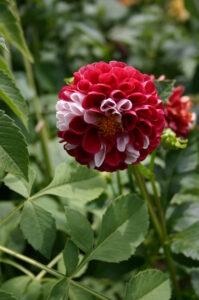
Dahlias have become a very popular flower to grow in home gardens, but in New England the season for them is normally quite short. It’s best to plant dahlia tubers outdoors when the ground temperature is above 55oF (12oC), which for me in Rhode Island means not until late May or early June. So if I have my dahlia tubers in the ground by, say, June 1st, these relatively slow-growing plants won’t produce flowers until mid to late August, when the first frost may be only six weeks away. That’s a very short time to enjoy the beautiful blooms.
This is where having a greenhouse comes in. By starting dahlias in my greenhouse, I’ve been able to significantly extend their blooming season, even until Christmas with appropriate management of heat and light. Having a greenhouse also enables me to start dahlias in March or April that I intend to eventually plant outdoors. With careful transplanting, I can have outdoor dahlias flowering for most of the summer.

This said, dahlias have specific requirements to produce good flowers on strong stems. They thrive in nutrient-rich soil that is slightly alkaline, with a pH of 6.5 to 7. In the greenhouse, potting soil with a coir base seems to work well. Commercial fertilizers used on dahlias are best lower in nitrogen and higher in phosphate and potassium. A 5-10-10 ratio is ideal. In my outdoor garden bed, instead of adding commercial fertilizer, I rototill in compost and well rotted seaweed.
March is a good time for starting dahlia tubers in pots. Pots for growing dahlias must be at least two inches larger all round than the tuber. I prefer pots that are relatively wide and made of black plastic because they seem to retain heat better than do grey or light-colored clay pots. Into each pot I set a tuber that has started to sprout after having been put in the warmth of my basement germination chamber. While doing this, care must be taken not to break off the shoot.

The potted tubers are then put on a heat mat in the greenhouse to help keep the soil temperature in the 65-70oF (19 to 21oC) range that these plants love. I also have grow lights over the emerging shoots for 12 to 14 hours a day. If they get inadequate light, the stems will be spindly and weak. When the plants are 10-14 inches (25-30 cm) tall, they should be hardened off by placing the pot outdoors for a few hours each day. In about a week, the plants will be ready to be planted in an outdoor bed. Using this greenhouse starting method, you can have dahlia blooms from mid- to late-June until frost.
Of course, if you want dahlias year after year in areas where the ground freezes, you must dig the tubers out each fall and store them in a cool, dry place during winter. Some people simply put them in a pot or box, but others take more care. I know of one dahlia grower who snips the tails off every tuber, washes off the soil, dries the tubers thoroughly, and packs them all in peat moss. I don’t go to this extent, but I’ve learned the hard way not to store dahlia tubers in my greenhouse, where the wintertime humidity is quite high. I lost more than 50 tubers to rot making this mistake. I now store dahlia tubers in a closed container in my garage, where they stay suitably cool and dry until ready to plant next spring.


